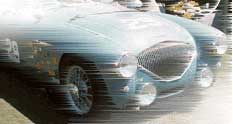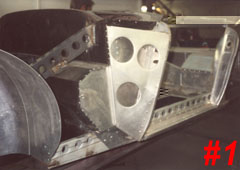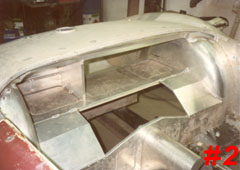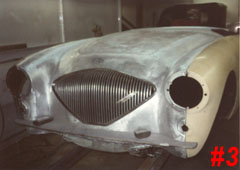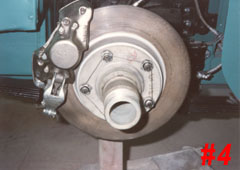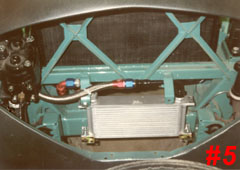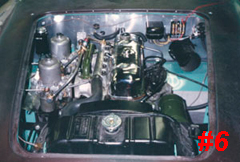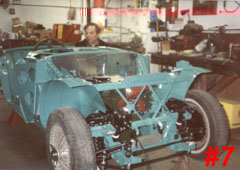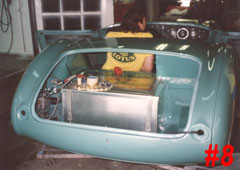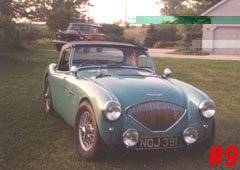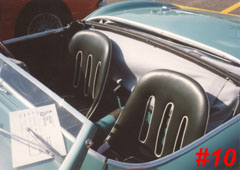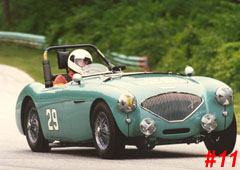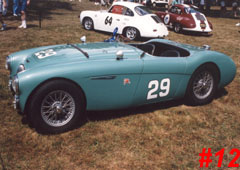 |
100S
Prototype |
||||
This very special Healey was built by Tom Kovacs of Fourintune with design assistance from Geoff Healey and Roger Menadue. The inspiration for this car was the 1954 special test car built by the Donald Healey Motor Company for the 12 Hour Sebring Race, NOJ 391, where as #29 it finished third overall! This 100 S prototype features:
Photo #4 is of the Dunlop disc brakes which were fit on both the front and rear of this racing Healey. Photos of NOJ 391 at Sebring in 1954 revealed that the factory had run 16" C Type Jaguar disc wheels. Geoff Healey told Tom that they used those wheels to compensate for the lack of gear ratios, but they gave the car poor handling characteristics. He recommended 15" wire wheels that were used on the later 100 S cars.
In photo #5, the modern day oil cooler with areo quip lines and fittings installed can be seen. Production 100 S cars are fit with a "hippo" style oil cooler which is inefficient and difficult to maintain.
The engine room of the car (photo #6) as it nears completion. The firewall is fit with bare aluminum to cover standard holes not needed on a race car. Discussions with Geoff and Roger revealed that the NOJ cars were fit with a tubular header which was custom built. Henry Westlake is responsible for major improvements to the S engine. The standard 100 head has trouble breathing at 4000 rpm, so Westlake insisted you move the intake and the exhasut over to the other side to get away from the push rod tubes. The eight-port head was the result and has excellent breathing. This idea necessitated a change in the top four inches of the block to get the stud and water pattern that Westlake wanted.
In photo #7, the chassis is a roller with the bottom end of the engine in place. The aluminum firewall cover was installed prior any of the wiring being hooked up. Once the engine was runing, the chassis was test driven to double check all the mechanicals prior the body being installed.
Since Tom chose the 1954 Sebring version of NOJ 391, the car has a huge fuel cell built to replicate the 24 gallon tank used for that race. Photo #8 shows the modern day cell custom built to original specs. The oversized fuel filler location in the boot required a hole and rubber seal that was sketched for Tom by Geoff Healey. The hole was cut into the trunk lid and just fits around the LeMans type fuel filler cap.
This Healey was built to be a "dual purpose" car that can be raced or driven on the street. We tend to forget that many of the auto manufacturers in the 1950's drove the "race" cars to the track - this was their final "test drive!" Geoff and Roger always said it was the ultimate incentive for the mechanics to get everything right back at the factory. The 100 S engine is a superb engine for "dual purpose" use, and makes a terrific touring car.
NOJ 391 is in full street trim in photo #9. The Brooklands racing screen is removed and a full windshield with convertible top is installed. The top and windshield are the same style that were fit on the stock 100 cars. The seats (photo #10) however, are the 100 S type with the three slats in the backrest which keep the driver and passenger cooler at speed.
The car made its' racing debut at Road America's 1993 Chicago Historic Races (photo #11). Roger Menadue, experimental chief for the factory, helped finish the car at the shop and served as crew master once we arrived at Road America. Driven by Phillip Coombs ( #105 in the 1990 Challenge Series) the car finished second to another Fourintune 100 S owner, Dick Hansen, who was racing his MGA twincam.
That same race, the car took top honors in the British Production based Race Car Class. It was then selected as the "Best Race Car" beating several GT40s and Ferraris. The Healey continued to take top honors out on the race track with first place finishes in group 3D. Coomb's fastest lap in the car at Road America (4 miles) was 2:53.479. This is one fast four cylinder Healey!
Another major award came in August of 1998 at the Meadow Brook Hall Concours d'Elegance where #29 was shown in the Race Car Circle (photo #12). The concours is held every August on the grounds of the Dodge Mansion, which is part of Oakland University in Rochester, MI. This event has become the single largest fund-raiser to benefit the preservation of Meadow Brook Hall.The green car won the circle overall and was awarded the "Peter Helck Trophy" which is sponsored by the T.M. Smith Tool International Corp. Previous winners of this award include Miller, Cunningham, Scarab and Ferrari cars. The 100 S prototype is the first Austin Healey to ever win this award!
To read more about this car and the current owner who vintage races this Healey, click here.
|
|
|||
|
|
||||
